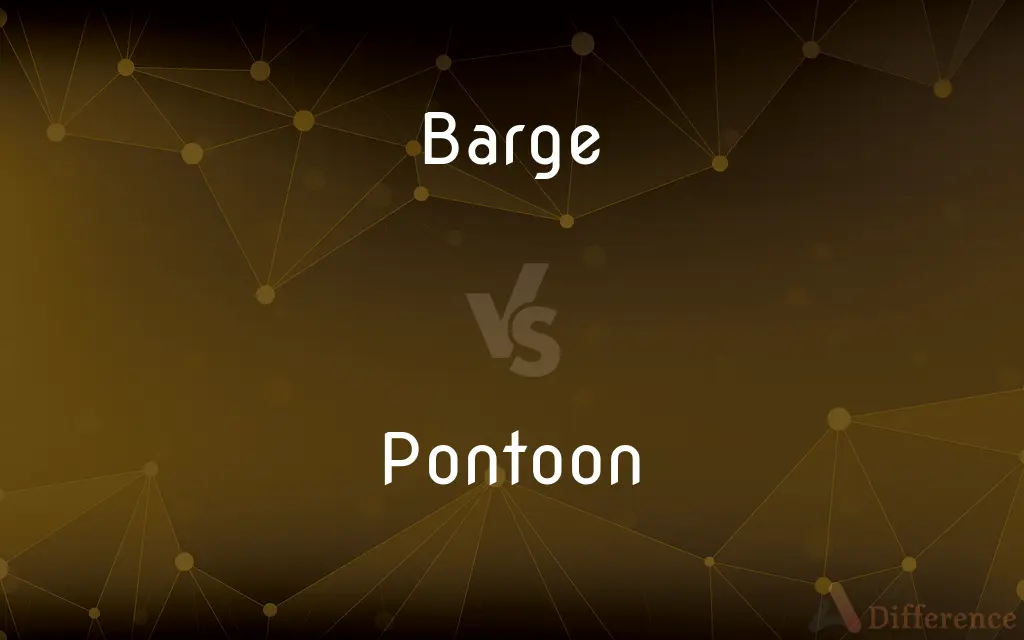Barge vs. Pontoon — What's the Difference?
By Fiza Rafique & Urooj Arif — Updated on March 5, 2024
A barge is a flat-bottomed vessel for freight transport, while a pontoon supports floating structures.

Difference Between Barge and Pontoon
Table of Contents
ADVERTISEMENT
Key Differences
Barges are designed primarily for the transportation of heavy goods and materials along rivers, canals, and coastal areas. They are known for their large capacity and flat bottoms, which allow them to carry heavy loads with stability. On the other hand, pontoons are used as floating supports for various structures, including bridges, docks, and recreational platforms. Their buoyant tubes enable them to float and support weight on water.
Barges are often unpowered and require tugs or towboats for movement. Unlike barges, pontoons are not specifically designed for transportation but for stability and support in water-based construction and leisure activities.
Barges, being integral to commercial and industrial shipping, are built to navigate through narrow and shallow waterways, optimizing transport efficiency and cost. Their construction is robust, suited to carry bulk commodities like coal, grain, and ore. Pontoons, in contrast, are versatile in their application, supporting floating homes, recreational boats, and even floating gardens. They are constructed from materials like plastic, aluminum, or fiberglass, designed to offer buoyancy and stability rather than cargo capacity.
While barges contribute significantly to the economy by facilitating the movement of goods, pontoons enhance recreational water activities and waterfront construction projects. Each serves distinct purposes in waterborne operations, reflecting their unique designs and uses.
Comparison Chart
Primary Use
Transporting goods
Supporting structures
ADVERTISEMENT
Design
Flat-bottomed for stability in carrying heavy loads
Buoyant tubes for floatation
Propulsion
Often unpowered, moved by tugs
Varies, can be self-propelled or stationary
Construction Material
Steel or wood
Plastic, aluminum, fiberglass
Applications
Industrial and commercial shipping
Recreational, construction, floating platforms
Compare with Definitions
Barge
A large, flat-bottomed boat for carrying freight on rivers and canals.
The barge carried coal down the river to the industrial plant.
Pontoon
Used in recreational watercraft.
Families enjoy renting pontoon boats for leisurely lake outings.
Barge
A vessel often towed by another.
Tugboats towed the barges through the canal.
Pontoon
A floating structure used to support a bridge or dock.
The floating dock was supported by pontoons.
Barge
Used for heavy transport on waterways.
Barges are essential for transporting bulk goods efficiently.
Pontoon
Can support floating platforms for events.
The concert stage was set up on a large pontoon on the river.
Barge
Can be residential or commercial.
Some barges on European rivers are converted into floating homes.
Pontoon
Versatile in water-based applications.
Pontoons are used to construct temporary bridges in flood zones.
Barge
Integral to inland water transport.
The extensive network of canals in Europe is navigated by barges.
Pontoon
Part of a boat or raft that provides buoyancy.
The pontoon boat glided smoothly across the lake.
Barge
A barge is a shoal-draft flat-bottomed boat, built mainly for river and canal transport of bulk goods. Originally barges were towed by draft horses on an adjacent towpath.
Pontoon
A flatbottom boat used to support a bridge.
Barge
A long, large, usually flatbottom boat for transporting freight that is generally unpowered and towed or pushed by other craft.
Pontoon
A floating structure that serves as a dock.
Barge
A large, open pleasure boat used for parties, pageants, or formal ceremonies.
Pontoon
Either of a pair of floats supporting a boat or seaplane.
Pontoon
A flat-bottomed boat or other floating structure used as a buoyant support for a temporary bridge, dock or landing stage.
Common Curiosities
What is a barge used for?
A barge is used for transporting goods along rivers, canals, and coastal areas.
Can barges move on their own?
Most barges are unpowered and require tugs or towboats to move.
How do pontoons float?
Pontoons float using buoyant tubes that displace water to support weight.
Are pontoon boats suitable for fishing?
Yes, pontoon boats are popular for fishing due to their stability and space.
What are pontoons made of?
Pontoons are made of materials like plastic, aluminum, or fiberglass for buoyancy.
Are barges only used for commercial purposes?
Primarily, yes, but some are also used for residential purposes, like houseboats.
Can a pontoon support a house?
Yes, pontoons can support floating homes and other structures.
How much weight can a barge carry?
This varies greatly, but some barges can carry thousands of tons of cargo.
Do all waterways allow barges?
Barges are allowed in waterways that are deep and wide enough to accommodate them.
Can pontoons be used in the ocean?
While designed for calm waters, some pontoons can be used in protected ocean areas.
What makes barges efficient for cargo transport?
Their large capacity and flat bottoms make them efficient for bulk transport.
What's the difference in construction between barges and pontoons?
Barges are built for heavy loads and durability, whereas pontoons are designed for buoyancy and versatility.
Are pontoons only for leisure activities?
While often used for leisure, pontoons also support construction and commercial activities.
Can you live on a barge?
Yes, some barges are converted into houseboats for residential living.
How are pontoons attached to structures?
Pontoons are anchored or connected with frameworks to support structures.
Share Your Discovery

Previous Comparison
Distinguished vs. Exceptional
Next Comparison
Yell vs. ShoutAuthor Spotlight
Written by
Fiza RafiqueFiza Rafique is a skilled content writer at AskDifference.com, where she meticulously refines and enhances written pieces. Drawing from her vast editorial expertise, Fiza ensures clarity, accuracy, and precision in every article. Passionate about language, she continually seeks to elevate the quality of content for readers worldwide.
Co-written by
Urooj ArifUrooj is a skilled content writer at Ask Difference, known for her exceptional ability to simplify complex topics into engaging and informative content. With a passion for research and a flair for clear, concise writing, she consistently delivers articles that resonate with our diverse audience.
















































